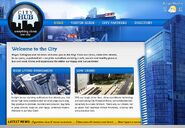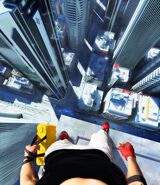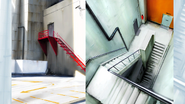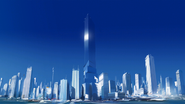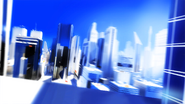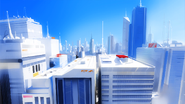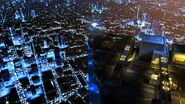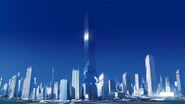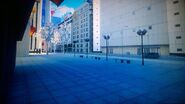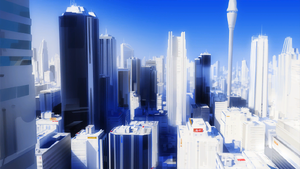
An overview of the City
Overview[]
The City is a large dystopian metropolis, and the setting of the original Mirror's Edge. Colorful and vibrant, the majority of the colors within the city are white, blue, and orange (with a lack of red), while many building interiors are white, red, and green. It is under constant reconstruction and renovation, as construction materials and equipment appear in nearly every area.
History[]
“Once, this city used to pulse with energy. Dirty and dangerous, but alive and wonderful. Now, it’s something else. The changes came slowly at first. Most didn’t realize, or didn’t care, and accepted them. They chose a comfortable life. Some didn’t. And those who refused to conform were pushed to the sidelines. Criminalized. They became our clients.”
It began with a law movement known as the Citizenship Program; a program designed to ensure easier living by offering governed city solutions to the city's citizens. Various problems were stamped out as a result of the program, such as smoking and obesity. Those who wished to lead alternate lifestyles to what the city offered, however, were faced with difficulty if not outright blocked.
The Libertas movement arose to challenge the program’s way of dictating how people should live however as the demonstrations became more heated they eventually degraded into the November Riots and illegalized.
The city gradually became restructured to ensure better security and public safety; the architectural phenomena becoming known as New City, the remaining and slowly declining pockets of the original city became known as Old Town; turning into self-run ghettos and shabby streets without the benefits found in New City districts.
The non-conformers; those who did not wish to live under the program’s laws, were either criminalised, left the city or started forming underground groups to support their way of life. One such group was an underground specialized courier service known as Runners who ferry and deliver packages and various communications across the city beyond the city’s surveillance and censorship, however the city officials have been making progress in stamping out these ’‘illegal alternatives’‘ as well.
Media[]
Business[]
- Diggler's Donuts: a doughnut foodchain, the tagline is "Because Life is Sweet".
- Dryson: a motor company
- Nicpix: nicotine alternative
- Vegade: Vegade+, sold by the Raposa Food Company
- Wainwright's
Utility[]
- Callaghan City Construction or Callaghan Construction Corp: a construction company responsible for most of the construction activities in the city due to its CEO being mayor.
- City Protection Force
- New Stream Energy
- Pirandello Kruger
- Robert Pope & Associates
- Silvine Security Systems
- Z. Burfield International Shipping
Districts[]
- Centurian Plaza
- Docks
- Downtown
- Financial District
- Hampton Town District
- Harbor
- Looking Glass Gardens
- New Eden
- Old Town
- Ryding Park
- West Arlington
Buildings[]
Location[]
- The city takes place in the North American Eastern timezone, due to clocks around the city showing Eastern Time after the time, but the coast is similar to Seattle's coastline.
- The city appears to span multiple peninsulas of a coastal region and has strong visual similarities to Singapore, Hong Kong, as well as Sydney and Vancouver to a lesser extent, and possibly also London, with its incorporation of The Shard, an actual building in London, although not as architecturally similar.
- The city seems to have 2 official languages, English and Chinese (Mandarin).
- The presence of English, Chinese, and Japanese text around the city suggests a multi-cultural population. Interestingly, Singapore has English and Chinese as 2 out of its 4 official languages, the other 2 being Malay and Tamil, and Japanese signage's are also commonplace throughout the city-state.
Trivia[]
- The vegetation in the city is also white. It is assumed that this is simply the result of a gameplay mechanic to make it easier for the player to focus in the game by saturating out unnecessary colors, although in-game, they could simply be artificial plants placed for aesthetic purposes.
- The entire city reflects a modernist design sense, with no classic architectural styles at all, suggesting that the whole metropolis has been very recently built or rebuilt.
- Traffic is left-handed in the city, identical to Singapore and Japan.
- "West Arland", pronounced like "West Ireland", is referenced multiple times.
- Although set up as futuristic, the city and game's setting do not seem to be very far into the future; in the level "The Shard", while Faith is waiting for the elevator to ascend, a prerecorded announcement can be heard informing riders about the building, including that it was completed in 2012. Amazingly, there is an actual building called The Shard located in London, United Kingdom, that like its video game counterpart was also completed in 2012, construction having been started in March 2009. With Mirror's Edge having come out in November 2008, the game developers most likely heard plans of its construction years prior and simply incorporated it into the game, along with the proposed completion date at the time or the developers' lucky guess. Another callback is The Core, which in the aforementioned level refers to the server farm within the building which runs the citywide surveillance system, it's real world counterpart being the central region that was built first so The Shard could be built around it.
- While the architecture is pristine and completely modern, there are very few, if any, examples of buildings or technology shown which are inconceivable in today's real world. This contrasts to the City of Glass in "Mirror's Edge Catalyst", which does feature more typically futuristic technology and architecture, suggesting that it is further in the future.
- While the city is depicted as being full of tall skyscrapers in both the main menu and many of the levels, the city seen from the Shard contains many shorter buildings, likely due to an oversight or technical constraints at the time.




